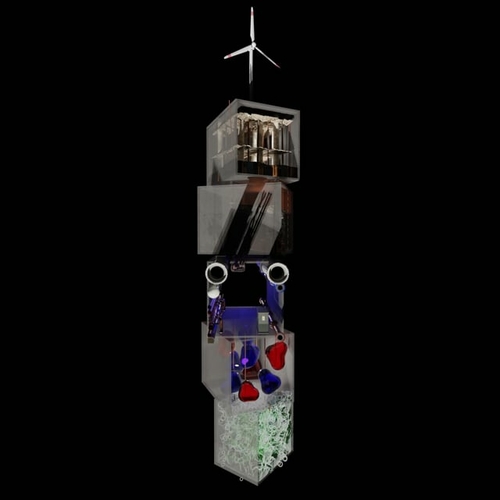The animation is based on the 2nd edition of the Academic Workshop Soil that included presentations by Frans Taselaar, Director of consultancy and engineering firm Hompe en Taselaar in Amsterdam, Ranjith Jayasena, Senior Archaeologist at the City of Amsterdam, and Suzanne Hangx, Assistant Professor ‘Reservoir Mechanics & Geo-energy’ at the University of Utrecht.
Amsterdam's geology features sand layers dating back to the Ice Age, including coarse sand, sharp sand, and gravel layers. Taselaar explained how these layers form a unique geological setup with significant potential for energy storage, with a key feature being minimal water flow of just a few meters per year. The animation shows Amsterdam's underground aquifers, exploring their hydrological and aquathermal properties. It visualizes the theoretical understanding of thermal energy storage underneath the city in ‘bubbles’ of cold and heat. The blue and red spheres symbolize these heat and cold storage bubbles, which expand and contract with the changing seasons. In truth, it is impossible to know what these underground reserves look like due to measurement limitations.
From an archaeological and urbanistic perspective, subsidence has significantly shaped Amsterdam according to Jayasena. Built on a delta landscape with soft soils, the city experiences ongoing ground subsidence requiring continuous topping up for streets and homes. The layering and compaction of soils affect the urban landscape. The constant movement of sand and clay particles, often mixed by human activity and natural processes, creates a rich archaeological archive underneath the city.
Hangx took us into the deeper layers of the subsurface, which remain largely uncharted and known only through drilling and modelling. In these mysterious depths, there is a need to explore the potential and risks associated with the complexity and uncertainty of deep subsurface engineering such as CO2 storage, geothermal energy extraction, and future hydrogen storage. These activities require an understanding of the permeability and stability of deep geological formations, which her team researches through lab tests of different geological materials. The microbial life at these greater depths is still not well understood and often overlooked in research but perhaps crucial to geological processes.
This 3D animation by Jaehun Park is an exploration of Amsterdam’s underground, blending geological, archaeological and technological themes to reveal the hidden dynamics that shape the city under the surface. Park’s animation highlights different systems and activities at different depths underneath our urban lives. It shows the layers of infrastructure that coexist beneath the surface: from shallow layers housing cables, pipes, and building foundations, to deeper layers hosting aquifers, potential energy storage systems, archaeological remains and deep geological formations. This layered visualization highlights the challenges and opportunities of managing the subsurface in a densely populated urban environment, and also raises questions about ownership and responsibility. It alludes to the unseen forces at play beneath their feet and the delicate balance required to maintain a habitable and resilient urban environment.
The continuous subsidence, paired with constant topping up, begs the question whether we are approaching both in the right way. Are we topping up at the same speed as the subsidence? Are there other ways we can cope with subsidence? The soil is the foundation of our city’s biodiversity but also its literal foundation. What is the impact of constantly importing sand and soil from elsewhere on the local soil ecology and quality? How do the materials of foundation piles – and other deep infrastructures - affect the soil and deeper subsurface layers once they are abandoned or out of use? What kind of life exists in the deeper subsurface underneath cities and how are our new geothermal infrastructures affecting it? When going deeper down, what are acceptable risks for new energy techonologies upon our urban geology?
About Jaehun Park
Jaehun Park’s virtual works deal with current problematic events on Earth by zooming in on cleverly chosen metaphors and objects. In his simulated video works, he translates physical substance using 3D scanning technology into virtual substance, such as polygon structures and point cloud systems (a set of data points in space). He uses hyper-realistic 3D rendering to stage mass-produced objects – as vessels of capitalistic ideology – in an abandoned digital space or to situate them in ‘ritualistic’ installations depicting impossible natural phenomena. The different kinds of staged objects depict dark Korean histories, but also violent histories of the entire human race. Moreover, these by-products of a hyper-capitalistic, machine-driven civilization and symbols of war unfold in a virtual hellscape – a place inhabited by ready-made 3D digital objects as well as instruments of torture and tortured humans. A seemingly unreal landscape; perhaps closer to the reality of our time than we wish to believe.
Park doesn’t shy away from anything in his work. With his simulation algorithms, manipulated and staged virtual landscapes, and installations, he reveals the tip of the real world – oversaturated by hideous and glorious moments of capitalism. Desire, vanity, guilt, irrationality, and indebtedness become resources in the ‘ritual’ space of capitalism. The concept of hell doesn’t manifest itself after death, but here in this hellish reality.
Jaehun Park (1986, South Korea) lives and works in Amsterdam and Seoul. Graduated from the Department of Painting (BFA, MFA) at Seoul National University and Master Artistic Research at the Royal Academy of Arts in The Hague. Recent exhibitions include Topographic Atlas, JAN Museum, Amstelveen (2022), Art and Peace: Let us begin again from zero o’clock, Ulsan Art Museum, Ulsan (2022), Alternative Space Loop Seoul (2021), Sign Project Space Groningen (2021), Photo Basel (2021), Unseen Amsterdam (2021), Project Space 1646 The Hague (2019), and Artspace O Seoul (2016). His work is part of several collections including Amstelveen Municipal Art Collection, Normec, The Seoul Foundation for Arts and Culture, Korea Institute for Advanced Study and the Seoul National University Health Service Center.
Source: galleryviewer.com
